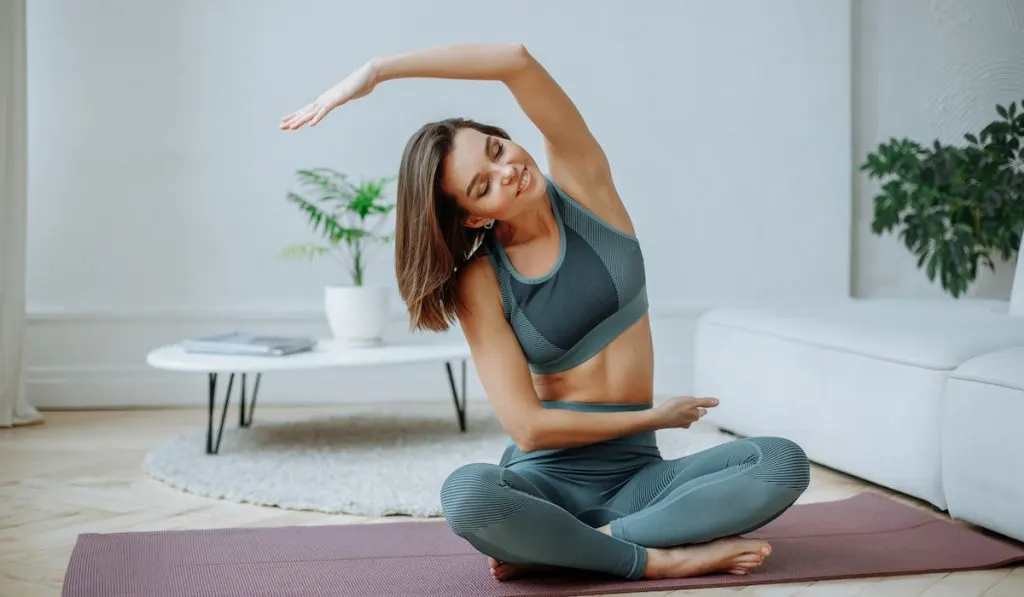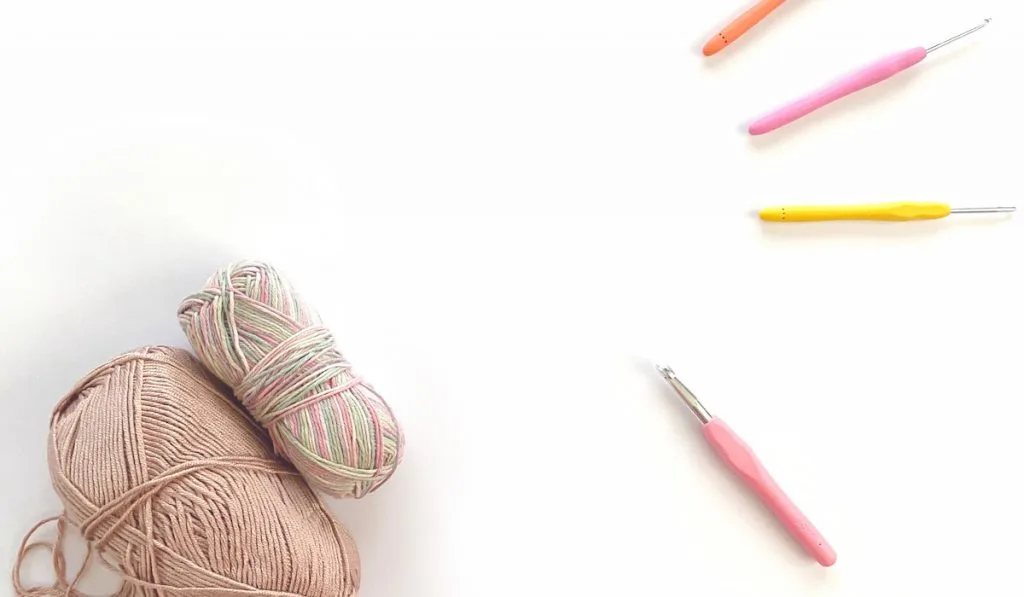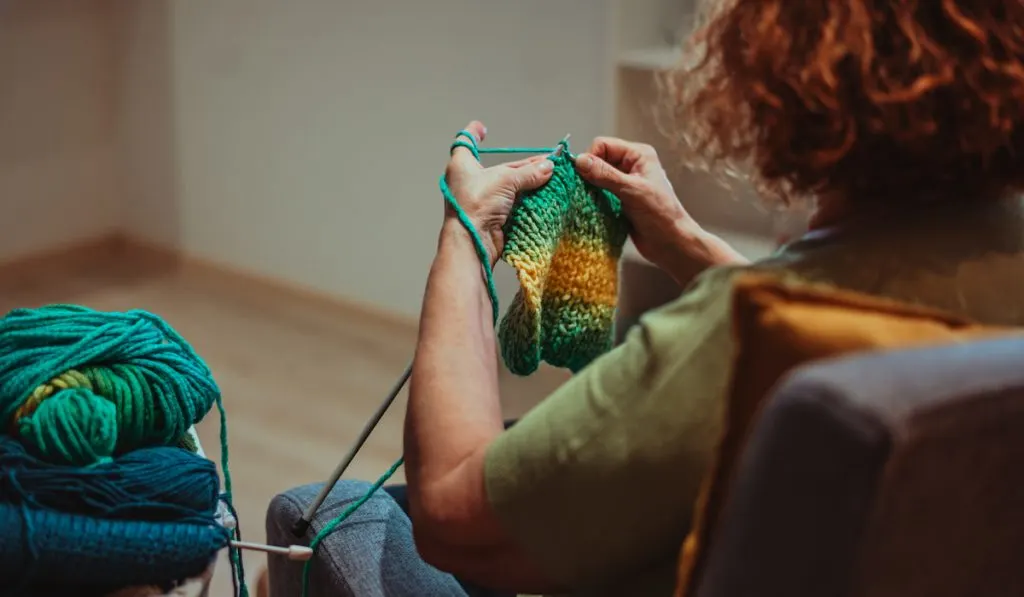Experiencing pain from crocheting is the biggest nightmare for every crocheter out there. It doesn’t matter how much you love crocheting, if you overdo it, at the end of the day you will be unknowingly inflicting pain on yourself.
Depending on the hand that you use to do your needlework, the damage can slowly creep onto your arm and as soon as the pain starts, it gradually slows you. If not taken care of, it may completely stop you from being able to crochet.
Can crocheting hurt your shoulder? Can you treat shoulder pain experienced from crocheting? How do you prevent shoulder pain when crocheting? Read on for a clear focus on shoulder pain, the causes, and how you can prevent it from happening.
Can Crocheting Hurt Your Shoulder?
Even though crocheting is both calming and distressing, it is a repetitive activity that may cause harm to your shoulder if overdone.
Frozen shoulder is a condition commonly associated with crocheting due to the repetitiveness that makes the shoulder stiff and limits its mobility.
Many factors lead to the development of shoulder pain, including your sitting posture. It is true that after some period of constant crocheting, you might forget to maintain your posture and later experience neck and back pains.
To avoid shoulder pains when crocheting, however, there are 3 primary precautions concerning your posture.
First, find a good chair with back support, that way, you will always sit upright without slouching.
Secondly, always maintain your feet flat on the ground, keeping the knees at a level with, or slightly higher than the hips.
Lastly, always maintain your arms at your sides and if possible, help elevate your elbows with cushions or prop pillows.

What is a Frozen Shoulder?
Also known as adhesive capsulitis, a frozen shoulder is a disorder that affects the joint capsule in the shoulder, often resulting in stiffness, pain, and eventually a total loss of mobility if not taken care of.
This condition is caused by a poor sitting posture, especially with hobbies that involve extended periods of sitting such as sewing, knitting, and crocheting. The signs will gradually show and worsen over time. On the bright side, however, the pain will go away after some time, say 1-3 years.
Although the cause of a frozen shoulder is unclear, individuals with fewer shoulder movements like those with hobbies such as crocheting are more likely to have this condition.
However, shoulder immobility could also be caused by stroke, a broken arm, injury, or surgery recovery. Frozen shoulders are also more likely to happen to the elderly, especially those above 50 years, with women being more prone compared to men.
From the onset, a frozen shoulder progresses in three stages, and depending on the intensity of the encouraging factor, like bad posture, each stage might even last for a couple of months. Below, the stages are elaborated;
- Freezing stage – This is the initial stage where the shoulder movements start getting limited, and even the slightest shoulder movements, besides the “normally adjusted-to” position, can cause pain that often worsens at night. Typically, this stage lasts from 6 – 9 months.
- Frozen stage – During this stage, the shoulder is “frozen”, meaning that the pain gradually reduces, but the shoulder becomes even stiffer and more difficult to move, and can last for 5 – 12 months.
- Thawing stage – During this stage, your shoulder mobility improves, with more range of motion, and can last anywhere from 6 months to 2 years.
As a devoted crocheter, you can avoid a frozen shoulder by taking short breaks in-between tasks and doing simple stretches. If you are already affected, over-the-counter drugs like ibuprofen can help ease the pain but if the pain persists, you should consult your doctor for specialized treatment.
11 Expert Tips to Stop Pain When Crocheting
As much as crocheting can be a calming and relaxing activity, its repetitiveness might cause a frozen shoulder over time resulting in loss of mobility. However, if you don’t want to lose your hobby and most importantly, maintain your body and health, following the tips below will help you ease and avoid shoulder pains when crocheting;
1. Consult Your Doctor

When you are no longer sure on how to manage your shoulder pain, consulting your physician is the right step to get a good diagnosis of the situation and get the right prescription to counter the injury.
Alongside a recommendation to frequently visit a physical therapist, a doctor might recommend any of these three treatments;
- A corticosteroid injection – The doctor injects a steroid into the shoulder joint to help ease the pain and adjust mobility.
- A joint distension – Here, the doctor injects sterile water into the affected joint capsule, consequently helping to ease the shoulder mobility.
- Surgery – Although rarely implemented, arthroscopic surgery is only advisable if all other methods have failed.
2. Take a Break
Unless you want to damage your body and quit crocheting for good, you have to listen to your body and give it the rest that it needs by having frequent breaks in between tasks. These breaks help your joints to reduce inflammation, resulting in fast healing of sore joints.
On the other hand, if you are already having joint pains when crocheting, you have to limit your crocheting periods. Try cutting the crocheting time by half compared to previous times if you want to keep crocheting longer.
Short breaks especially help you avoid marathon crocheting (crocheting for extended hours or sessions), and is especially helpful if you are already experiencing shoulder pains. If you don’t have the pains yet, it is a good practice to avoid any possible pains. Although it may feel like the end of the world, long breaks, on the other hand, could last days or even weeks but help mend and put in shape your elbows, hands, wrists, back, and shoulder. Long breaks are always good if you want to trek farther with crocheting.
3. Stretch

When having your breaks, simple stretching exercises help ease the tension in the hands, shoulders, upper backs, wrists, and neck. The stretching tasks only take a few minutes but are helpful and essential in maintaining your crocheting experience fun.
Since prolonged concentration on crocheting can cause neck and shoulder pain, here are two exercises to counter the pain;
- To release your neck pain, turn your head five times in both directions while maintaining your ears close to your shoulders, and the shoulders should be kept down too. After, flex your head back and forth five times too.
- To release the tension on your back and shoulder, roll them back and forth in each direction five times, then squeeze the shoulder blades together for a count of 10, then relax for a count of 20. Repeat this procedure thrice during every break and you should be good to go.
4. Physical Therapy
Although it may not impact the pain from a frozen shoulder, physical therapy helps in enhancing mobility and is more effective during certain stages than others. A therapist will help you perform simple tasks that you can further do on your own, like stretching or can also perform more complex tasks on you like acupuncture.
Acupuncture is a physical therapy method that utilizes tiny needles that are pricked into the muscle for controlling inflammation. The needles aid in stimulating new blood flow, gradually helping to heal the affected joint.
However, it is only performed by trained, skilled, and licensed physical therapists. The thin monofilament needles used are responsible for managing trigger points of neuromusculoskeletal pains and mobility difficulties, subsequently helping to heal the said injuries.
As scary as it might look, acupuncture might be a little uncomfortable, to be honest, but is never painful, and to seal the deal, the therapy is very effective. With just a few sessions of therapy, your shoulder joint pains may go away.
5. Use Ergonomic Crochet Hooks

Ergonomic crochet hooks help you relieve pain and stiffness in your hands and wrists, enhancing comfort when crocheting. Although they might be cheaper, ordinary crotchet hooks need more energy when gliding through the yarns, but with the correct ergonomic crochet needle, you will barely feel it gliding through the yarn while at your task.
6. Support Your Elbows
Crocheting is all about relaxing so as you take up the activity, ensure you are relaxed. You could use your stuffed pillows or blankets to raise your elbow for more comfort when working on the crochet.
7. Chiropractic Care and Massage
Regular chiropractic care and massage help to keep your spine in line and the general body in shape. On the shoulders, specifically, a simple massage helps release the tension in muscles and if done correctly, you might not even feel any pain for a while. This type of care is highly recommended for devoted crocheters or those who crochet daily.
8. Topical Treatments
When you experience pain from crocheting and need instantaneous pain relief, applying topical treatments could help you rapidly reduce the pain. Treatments like ice, heat, or CBD oil are effective in the reduction of pain.
Simply placing ice on the affected joint area greatly reduces the pain and inflammation in the shoulder.
Heat, on the other hand, can also be an effective and instantaneous pain reliever. In this case, a warm bath or shower after crocheting will help you relieve the tension and stress of crocheting on your shoulder and back muscles. Alternatively, applying a heating pad on the shoulder joint experiencing pain will help reduce the pain.
Some oil products like cannabis oil also have healing powers, and smearing it on the affected joint can greatly help reduce the pain.
Topical treatments, along with other therapies, should help you reduce the pain in the affected shoulder without much strain.
9. Compression Gloves
Also known as stress relief gloves, compression gloves help you combat the stress and tension accumulated by fatigue and strain due to the repetitiveness of crocheting. They provide light support around your arms, wrist, and fingers, aiding in blood circulation and delivery of oxygen to the fingers, and subsequently throughout the arms up to the shoulders.
10. Differentiate Skills

Repetitive activities and hobbies like crocheting will often have you doing the same thing repeatedly without really worrying about anything else, but you must be concerned with your posture. Having different skills will therefore help you relax your muscles periodically, especially if you are doing something related to crocheting, like knitting. The two tasks might look similar in how they are handled, but knitting is less intensive compared to crocheting. This way, you will periodically give your tendons and muscles the much-needed break to keep fit.
11. Find Additional Triggers of Pain
Shoulder pains may persist even after a long period of therapy and adherence to other tips of keeping the body fit when crocheting. In this case, you will have to look into other daily activities that may cause shoulder pains. Heavy duties and activities like carrying heavy loads may also cause harm to your shoulders and back.
Unlike using yarns bamboo fibers, linen, or cotton that have little give, using softer ones like acrylics and wool will help reduce the strain caused to your muscles.
You can also switch projects when you start experiencing pain in your shoulders. Switching to either a larger or a smaller yarn with a different hook to do the crocheting will adjust your hand, fingers, and even your position to fit the new task, helping to evade the problematic position and activity.
Conclusion
Pain from crocheting often leaves you with so many questions, wondering what next? Might this be the end of crocheting?
Well, shoulder pains are not the end of the world for you, Crafter. Applying the techniques above will help you overcome the pain eventually, but if the pain persists, revisit tip number one: consult your doctor!
Resources
- https://www.happilyhooked.com/blog/can-crochet-hurt-my-body/
- https://www.acrochetedsimplicity.com/how-crocheting-can-cause-permanent-damage/
- https://www.ilikecrochet.com/magazine/crochet-articles-and-interviews/self-care-avid-crocheter/
- https://www.twobrothersblankets.com/crochet-pain-how-to-feel-better-fast/
- https://lepetitsaintcrochet.com/2020/02/20/10-ways-to-stop-pain-from-crocheting-and-knitting/
- https://crafttribeonline.com/can-crocheting-cause-frozen-shoulder/
- https://www.happilyhooked.com/blog/how-to-prevent-pain-when-crocheting/
- https://kirstenhollowaydesigns.com/2019/11/8-stretches-that-help-avoid-pain-while-crocheting.html
